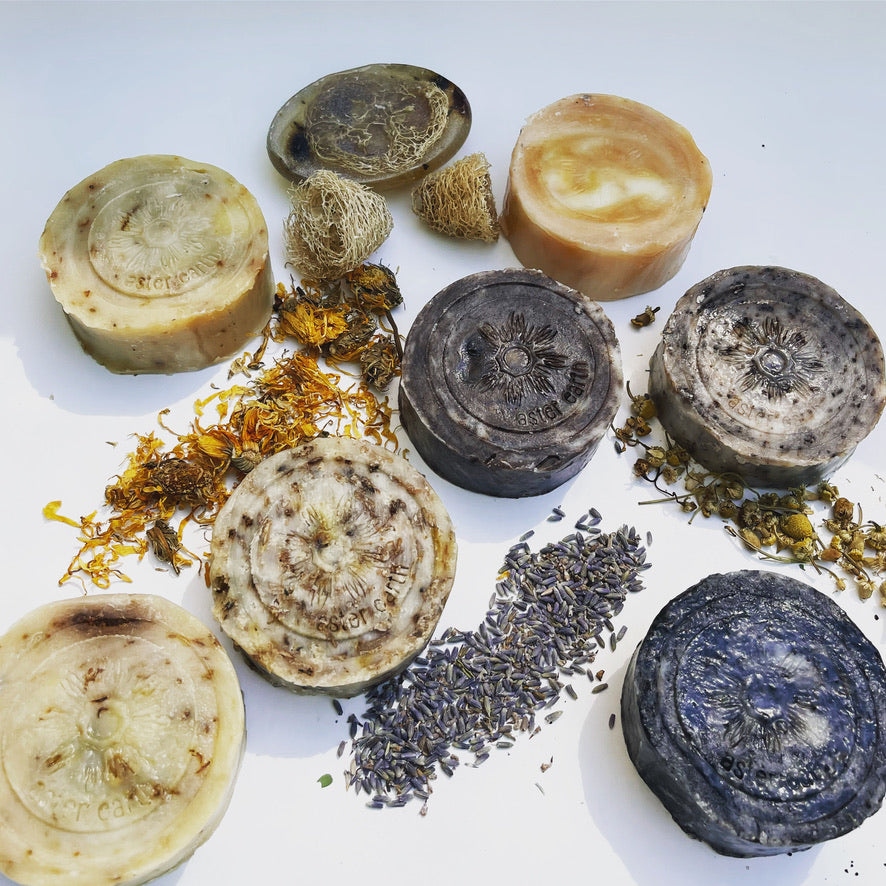"So...what's the difference between one of your bars and a bar of soap I buy at the store?"
-A customer at my show this weekend

The dirty truth is the majority of soap from big corporations, isn't soap.
Yes...you read that correctly.
Soap is the product of "saponification." This is the fancy term chemistry nerds like us use to explain the process where liquid oil is turned into a solid bar (or a thick liquid) that lathers and cleanses the body. Saponification happens when the oils are exposed to the very basic (not like mundane and boring basic, but actually basic on the acid-base scale) sodium hydroxide (NaOH). You can also use potassium hydroxide here and that results in a liquid soap. When the oil and the basic sodium hydroxide are combined an exothermic reaction occurs. Exothermic means heat is released during the reaction. The sodium hydroxide, or lye, is the limiting reagent in the reaction. This means that when all of the sodium hydroxide is used up, the reaction stops happening. That is why no actual lye remains in your artisan soap once it gets to you. It has all been used up in the saponification reaction. The remaining product of the reaction is a lathery bar of moisturizing goodness.
If all of that was too much for you, we get it. Not everybody loves science like this...so not to worry. The point of the previous paragraph is to define what soap actually is.
Soap is oils that have been exposed to a very basic compound (sodium or potassium hydroxide) and undergone saponification to become a lathery. lovely product of solid or thick liquid form.
See...is that better? Less, um, technical and nerdy?
Most of the bars you buy on the shelf for $1.99 are going to leave you feeling "squeaky clean." That sensation is not a good thing. It means your skin has been stripped of all its naturally occurring oils and is currently freaking out. The reason these bars leave you feeling dried out like a lizard, is because oil is the most expensive part of making soap. In the saponification reaction if you can maximize water and other chemicals and minimize oils, you are increasing your profit margin. Good for the business banking, not so great for your consumers.
Throw in some synthetic colors and fragrances and a few other potent chemicals and you have a bar of something that could technically pass as soap, but your skin may beg to differ.

Let's dive in just a little deeper.
Come on...you got this. We have life preservers.
When soap is made, the chemist has the ability to define what is called the "superfat" level. This is essentially the percentage of oil left over after the saponification reaction occurs. So, once all the sodium or potassium hydroxide is exhausted, how much oil remains in the soap? That is our superfat level. Here at Aster Earth, we use the highest percentage we can and still render a solid product. It's why our soaps just hum a little differently. We had to develop a specific process (not hot, not cold) to create our soaps and maintain that lather that you know and love.
Now, if you were a big big company and you
- want to cut costs
- make real soap (not just some chemicals combined and shaped into a bar that looks like soap)
You would adjust your superfat level. You would decrease it as low as you can go, so the amount of oils you need for each batch would also decrease right along with your price for production.
That's where squeaky clean comes in. There's no oil left in the bar to nourish your skin, so your skin is left feeling stripped and desiccated.
We're not in the business of poo-pooing others. The world requires all spectrums to function and let's face it, if you never experienced a standard bar of soap, ours wouldn't feel so good to you.
However, the question gets asked...a lot...and we thought it was time to answer it.
If you'd like to poke around on our soap page, you can find it here...
soaps
We promise to always make real soap, from real plants, by real hands, that really lather and love on your from head-to-toe.
